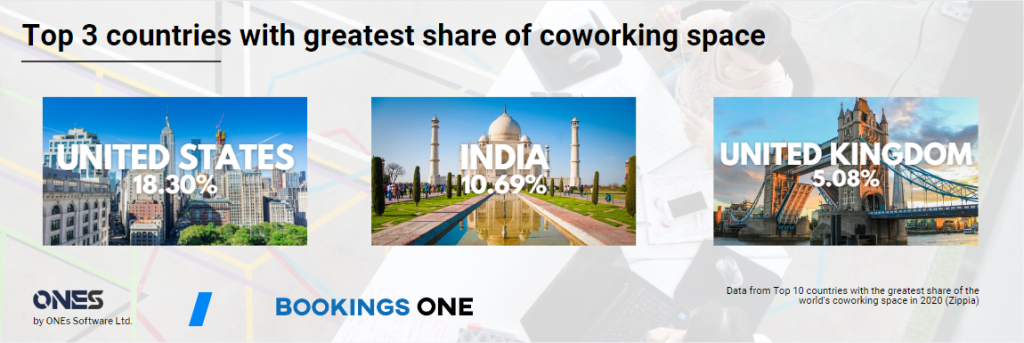A coworking space is a workspace created for workers from various organizations to join together to work. Shared facilities, services, and tools distinguish coworking spaces.
Are you looking for the latest updated data on coworking spaces? We’ve compiled a list of the most eye-opening coworking statistics for 2023 to help you completely understand the state of coworking spaces and their place in the world today.
Table of Contents
General Statistics

Number of coworking spaces worldwide

In 2020, there will be 19,421 coworking spaces globally. According to predictions, by the end of 2024, there will be 41,975 coworking spaces globally. (Statista)
Number of coworking spaces in the United States
By 2017, there will be over 4,000 coworking spaces in the United States. According to predictions, there will be around 6,200 coworking spaces in the United States by 2022. (Statista)
Who uses coworking spaces in general?

In 2017, around 1.18 million individuals worked in coworking spaces globally. Between 2021 and 2024, the number of individuals working in coworking spaces is expected to treble, reaching five million.
(Statista)
Freelancers make up about 42% of coworking space members worldwide, while the IT industry employs 20% of those working in coworking spaces.
(Zippia)
Who uses coworking spaces in the United States
In 2017, there were 542,000 individuals working in coworking spaces in the United States, and this figure is expected to rise to almost 1.08 million by 2022. (Statista)
Do coworking locations become profitable?
Although only 40% of coworking spaces are currently profitable, nearly three-quarters become profitable within two years of their launch.
Coworking spaces rely on membership fees as their primary source of income, but the majority of startups rely on the owner’s other sources of income during their initial period of operation.
Global distribution of coworking spaces
With the exception of the United Kingdom, coworking spaces are divided fairly evenly throughout major economies, with the Asia Pacific region having the largest single market. (Statista)
The U.S. has 18.3% of the world’s coworking spaces. Asia has the highest average capacity with 114 people per coworking space, and South America has the lowest at 54 people. (Zippia)
Top 10 countries with the greatest share of the world’s coworking space

| Country | Number Of Spaces | World Share |
|---|---|---|
| United States | 3,762 | 18.30% |
| India | 2,197 | 10.69% |
| United Kingdom | 1,044 | 5.08% |
| Spain | 939 | 4.57% |
| Germany | 791 | 3.85% |
| Canada | 617 | 3.00% |
| Australia | 590 | 2.87% |
| Mexico | 508 | 2.47% |
| Japan | 411 | 2.00% |
| Brazil | 393 | 1.91% |
Number of coworking centers in global select cities
London, the British capital city, has more than 1,400 coworking locations inside its borders, making it the city with the most coworking offices in the globe.
London has around 1,000 coworking spaces, more than the 550 coworking centers in American New York.
Hong Kong ranked third, with around 320 such sites.
(Statista)
Cities with the greatest increase in the number of coworking centers globally
New Delhi, India’s capital, has the greatest yearly growth rate in terms of coworking spaces worldwide.
Between 2018 and 2019, New Delhi might see a 50% increase in the number of new coworking spaces. Second in the ranking was Toronto, Canada, which had a 35% increase in coworking spaces over the same time period. (Statista)
Proportion of individuals who believe flexible working is the new normal
According to the report, 80 percent of Japanese respondents believe that flexible working is the new normal.
Only 68 percent of Germans said flexible working hours were the new normal. (Statista)
Proportion of members who still work at their first coworking space
According to the report, 55 percent of respondents still work in their first coworking space. (Statista)
Business Trends
Meeting spaces are in high demand
Meeting places were in great demand by the end of 2021, owing to the continued high number of virtual meetings. Individual offices were most popular in North America, whereas team offices were popular in large European cities.
The demand for ‘hot desks‘ was a mixed bag. It was much higher in Europe than the worldwide average. Event rooms, on the other hand, were more popular in North America.
(Deskmag)
More than a third of coworking spaces’ capacities are currently available
The higher the occupancy rate, the longer the coworking spaces had been open. Similarly, occupancy climbed as the size and number of sites increased.
However, even in the largest or oldest groups, this percentage did not reach 65 percent on average. (Deskmag)
A positive trend of flexible workspaces continues in 2022
The majority of flexible workspace businesses polled were optimistic about the start of 2022. In comparison to prior months, expectations were more cautious, particularly in Europe. When the survey was distributed, the Omicron wave was just beginning to rise after the Delta wave had passed its apex.
Within the following three months, 75% of respondents projected an increase in membership, while 60% expected better revenues and improved profitability. More than 20% of coworking spaces had already planned expansions for the start of the year. (Deskmag)
Major limiting factors to businesses of coworking spaces
The major limiting factors to the business of coworking spaces in various areas are:
- Fear of Coronavirus
- Attracting new members or customers
- Lack of planning certainty
- Not able to provide enough workspace
- Uncertain business prospects
(Deskmag)
The selling point of coworking spaces
According to a 2019 poll, “An enjoyable work atmosphere” is a selling factor for 70% of coworking spaces in the United States.
Work environment as a selling factor for a coworking space is at least partially unique to the United States, with 70% of the country’s coworking spaces reporting this as a selling point being at or above the worldwide average.
| “Well-situated location” | “Good service” |
| “Attractive design and fit-out” | “Low prices” |
| “Thriving community” | “Many events” |
| “Free parking” | “Multi-location access” |
| “Internet speed” | “Wellness emphasis.” |
(Zippia)
Coworking data by demographics
The worldwide average age of coworking space users
The average age of coworking space users worldwide is 36 years old.
However, this does not imply that the majority of members are in their thirties. Coworking space memberships are increasing in both the younger and older age groups.
Members of coworking spaces of all ages work in a variety of vocations. The elder members are typically consultants of some sort (which makes sense because they have the most skill in their industries), while the younger members are usually in public relations, marketing, or design. (Zippia)
IT industry participation in coworking
The IT industry accounts for 20% of coworking space members.
This is the most prevalent professional field represented by coworking space members, followed by public relations and marketing, consulting, and design.
The area of consulting is vast since it may apply to professionals in practically any subject, so if you chat to coworking members who fall into this category, you’ll discover that they work in a number of businesses. (Zippia)
Percentage of SMEs use coworking office spaces
The coworking space business model has proven to be quite successful, with target users including SMEs and startup teams. SMEs are currently the most common users of coworking spaces. Startup teams come in second with 27.12%, followed by freelancers with 16.61%. Surprisingly, digital remote employees account for only 2.82 percent of all employees.
Coworking data by companies
Top companies in the U.S. coworking space
WeWork, Impact Hub, and Spaces are the top three firms in the coworking space sector in the United States.
- WeWork has 800 sites worldwide and was the largest private office tenant in Manhattan, New York City, in 2018. It has over 600,000 members and offers hot workstations, dedicated desks, and private offices.
- Impact Hub already has over 100 sites in 50 countries and is continually expanding. It has over 16,000 members and focuses on bringing businesses together to establish community and sustainable growth.
- Spaces have almost 400 sites worldwide. It started in Amsterdam, the Netherlands, but today has operations on five continents, including North America.
(Zippia)
Top Rated Singapore coworking space
- JustCo’s smart workspaces, which have the largest coworking network in the Asia Pacific, are revolutionizing the coworking sector by fusing together several workspace types to allow businesses flexibility over when, where, and how they work.
- Leading provider of personalized smart office solutions, Distrii has expanded across Asia, working with over 20,000 users and 600 different enterprises.
- 40% of the Global Fortune 500 trust WeWork, a global corporation that specializes in the coworking industry. WeWork has built 10 locations, with the most recent in the Jalan Besar area, making it the 200th facility worldwide.
- The Great Room offers opulent, well-appointed coworking spaces that are well-situated in Asia-Pacific cities with vibrant, business-friendly neighborhoods.
- Servcorp, which houses 60,000 businesses in more than 150 prominent locations across the world, offers support unmatched by any other provider thanks to its industry-leading technology, highly skilled administrative staff, and flexible terms.
(osdoro)
Advantage of Coworking
Coworking Save Operational Cost
Utilizing these spaces rather than renting an office can save small firms with fewer than 12 employees about $2,700 each month.
Coworking Makes People Happier
In a thorough poll conducted in 2018, 89% of coworking users claimed to be happy, and 83% to feel less lonely as a result of using a coworking space.
Working in a coworking space makes people feel like they are a part of a community 86% of the time, which is consistent with another study that found that most coworkers are happier after joining.
(DeskMag) (smallbizlabs)
Coworking Leads to High Productivity
84% of coworkers say they are more motivated when working in a coworking space. 82% of coworkers report expanding their social network in a coworking hub.
About 68% of coworkers claim that working in a coworking environment greatly improves their ability to concentrate.
69% of coworkers claim to have picked up new skills while coworking.
(Zippia)
Related Article:
Productivity Unleashed: Designing Your Perfect At-Home Coworking Setup (porch.com)
ONES Software now has a dedicated page to introduce a series of hybrid working measures to help you solve problems. You may wish to go to https://ones.software/hybrid-workspace/ for further reference.
Contact us: hello@ones.software, or visit ONES Software official website for more information: https://ones.software/id/.


